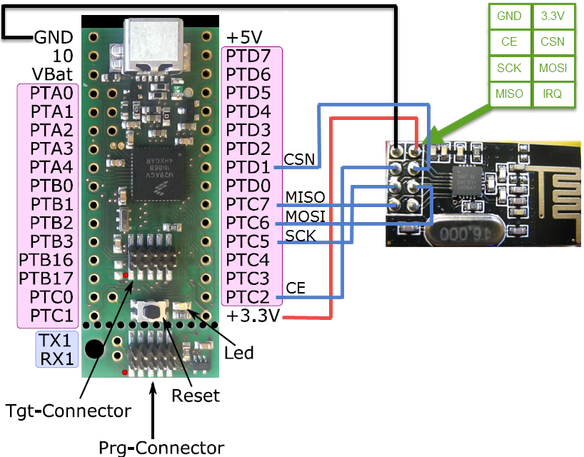Alternatively, a USB CDC or UART (Serial) connection can be used.
I’m not going much into details how to use the nRF24L01+, RNet and all the other components. Check the links at the end of this article for more details.
Summary
With this project I have the tinyK20 board enabled with 2.4 GHz wireless connectivity for less than $3 using the Nordic Semiconductor nRF24L01+ transceiver. I plan to use this in one of my next projects which need to have all board components in a small enclosure: here the tinyK20 fits well.
The sources of this project are available on GitHub here: https://github.com/ErichStyger/mcuoneclipse/tree/master/Examples/KDS/tinyK20/tinyK20_nrf
Happy nRF’ing
Links
- Using the Nordic Semiconductor nRF24L01+ transceiver: Tutorial: Nordic Semiconductor nRF24L01+ with the Freescale FRDM-K64F Board
- RNet stack: RNet Stack as Component, nRF24L01+ with Software SPI, Enhanced RNet Wireless Components and Communication Stack
- Segger RTT: Using Segger Real Time Terminal (RTT) with Eclipse
For more detail: nRF24L01+ 2.4 GHz Wireless Connectivity with the tinyK20 Board


How is this RF network in comparison with an RF network based on Freescale’s SMAC protocol over the MC1323x Transceiver (IEEE 802.15.4)?
The aspects that I’m interested in are:
– Reliability: The MC1323x Transceiver supports ACK mechanism for retransmissions, but it is rather complicated; we’ve implemented our own ACKing procedure at the application layer, which is less efficient of course; Can this Nordic Semiconductor nRF24L01+ transceiver be programmed “easily” for retransmissions as needed?
– Reception: We’ve encountered some extremely bad sessions with almost no RX whatsoever; we haven’t figured out the source of this problem; it could be a cellular antenna on the roof of our office building, but we’ve also experienced it in other places, in particularly when many other RF networks of various types (BT, Wifi, etc) are present in the vicinity; As a last resort, we’ve used the MC1323x Transceiver’s support for 16 channels between 2.405GHz and 2.480GHz. It doesn’t always resolve the problem, but still keeps the network “alive”. Does this Nordic Semiconductor nRF24L01+ transceiver support different frequencies in any manner